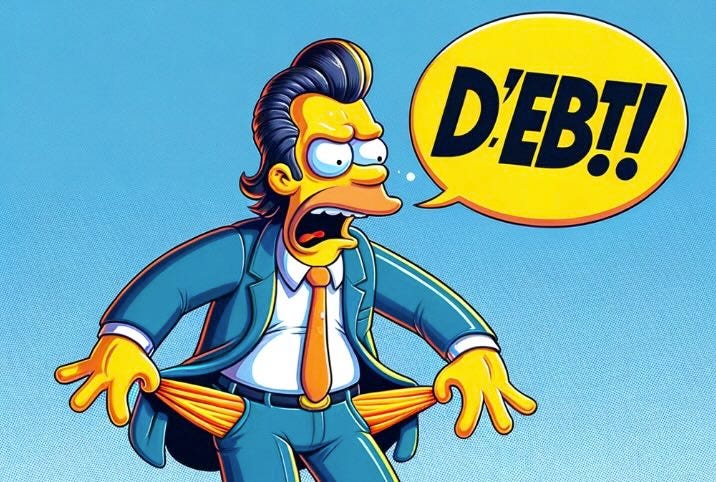5 Different Types of Debt That Can Hinder Your Product Organisation
Making sure that you're not crippled by organisational interest payments
Just a quick note that we also now have weekly One Knight in Product virtual networking as well as a Slack community. Join up now and meet cool product people!
In my 20s, I got into a lot of debt. As a fairly low-paid grunt in a fairly low-paying industry, there was no other way to sustain the lifestyle I wanted; living in London, travelling to cool places, buying a selection of guitars to play poorly in front of uninterested crowds. I had loads of wonderful experiences, but these came at a cost.
It got to the point where I was continuously refinancing my debt, through feats of financial engineering to try to move debt from one credit card to the next, or taking out yet another loan to consolidate all the other loans, making minimum payments on cards that would take (at that rate) 150 years to pay off. There are few things more financially depressing than seeing a number go up as you’re trying to pay it down!
In my work with scaling product organisations, I see different manifestations of debt all over the place. I’m sure you’ve seen them too. These can be just as depressing as financial debt when thinking about how to scale and grow a company.
Here are some of the main types of debt I’ve seen. Many of them share characteristics, but all represent different decisions:
Technical Debt
This is the obvious one. The thing that people always bring up. The thing that keeps developers awake at night. Now, let’s be clear, technical debt does not refer to just throwing terrible code, bug-filled out of the door and praying. Terrible code is terrible code, and we should never accept it.
Technical debt simply refers to the compromises you make knowingly to get your solution out to market faster. If you decided not to over-optimise your code to scale for a day that may never come, that’s technical debt.
Product Debt
Some people might consider this technical debt, depending on the nature of the debt, but not all technical debt is strictly technical. Product debt refers to the inefficiencies within your product that mean that the unit economics are going to get challenging down the line. Do you need to prop up your solution with services because you decided that was enough for now? That’s product debt.
Organisational Debt
Organisations are rarely designed. From the earliest startup to the mightiest enterprise, all organisations are the result of a collection of decisions that were all made for well-meaning reasons that may end up echoing through the lifetime of the company. These decisions build up, and all of a sudden you’ve got a PMO office at your SaaS company and nobody knows why. That’s organisational debt.
Vision Debt
Coined by Radhika Dutt, my three-time podcast guest, and author of “Radical Product Thinking”, vision debt refers to the decisions that you make for the survival of your company that are not aligned with your company’s vision. This does, of course, assume that your company has a vision! Every little thing that you compromise your vision on in the name of immediate revenue is vision debt.
Revenue Debt
I believe this is actually my concept, and it could be argued that it’s a manifestation of vision debt writ large, although it could also be argued that it’s very common in organisations with no vision at all. Revenue debt builds up as companies scale up through unstructured sales-led growth, selling to anyone they can, meaning that they start to build dependencies on a disparate set of customers who have sometimes substantially different needs. This makes focusing, or even saying no, too difficult because there’s too much revenue tied up in each segment.
To pay off your debts, you have to name them
Getting out of my personal debt hole took years, but the thing that got me started was the most important step of all. Actually admitting that my debt was unsustainable, and coming up with a structured plan to pay it off. For far too long, I just buried my head in the sand, tactically solving problems as they came up (just… one… more… credit card) and hoping that it would all work itself out one day.
Doing a full audit of my debt was the first step in actually paying it off. Understanding the impact that the debt was having on my finances, what debt was most painful, and the various scenarios that would have to play out to get me onto an even keel again.
Now, financial debt is, admittedly, easier to conceptualise than some of the more ephemeral debt that can build up in an organisation. But, the first step is to start to map the impact of the debt. And, just like with my financial debt, working out the debt that you can carry and the debt that you need to pay off.
After all, not all debt is created equal. Once you list out all of the debt that your organisation has, start to calculate the interest rate on that debt. Financially, that’s the vig that you’re paying on the money you owe. Organisationally, that could be the hit you’re taking on efficiency, the high cost to serve, or the lack of ability to get new stuff out and sell it.
Some debts you might accept as low-risk enough to carry them for a long time. I like to think of myself as debt-free these days, but I still have a mortgage. You might well consider that some of the debts your organisation carries are similarly low-interest and not worth paying off. Despite what the loudest engineers might claim, there’s some technical debt you may never pay off. It’s all a balance.
Like anything, debt can be a useful tool to help you hit your goals. Just avoid the equivalent of payday loans, make sure you keep up with your interest repayments, and make sure you manage your debt purposefully rather than by mistake. Your metaphorical wallet will thank you!
There’s still time to sign up for “Succeeding in B2B Product Management”
One of the reasons that I’ve been struggling to get newsletters out recently is that I’ve been spending a lot of time working on the course that I’m running with Saeed Khan. We’re halfway through our first cohort, and the second is starting very soon! If you want to come along and find out how to handle your revenue debt or overcome some of the other common struggles that B2B product managers have, come and sign up now. You can use code MEDIUM150 to get a tasty $150 discount.
Time to catch up on some old podcast episodes
In case you’ve missed them, I’ve got 3 podcast episodes to catch up on!
I spoke to Lloyed Lobo, author of “From Grassroots to Greatness” about his journey from kid fleeing the Gulf War to startup founder, community builder and now fitness guru. Lloyed is a massive advocate of community-led growth, and we talked all about how that can help you scale your business without VC funding. Check the episode out here.
I also spoke to Shyvee Shi, product lead at LinkedIn and a passionate educator of product managers. She’s gotten herself caught up in the new wave of generative AI and she’s not afraid to tell us all about it, both through her new book “Reimagined: Building Products with Generative AI” as well as this interview about some of the main themes of doing just that. Check the episode out here.
And if that wasn’t enough, I also spoke to Becky Flint, CEO of Dragonboat, who has a keen interest in all things product and portfolio management. Becky has some strong opinions about product operations, what product ops people need to be able to do well if they want to be worth their jobs, and the idea that even small companies should treat their products as a portfolio. Check the episode out here.




